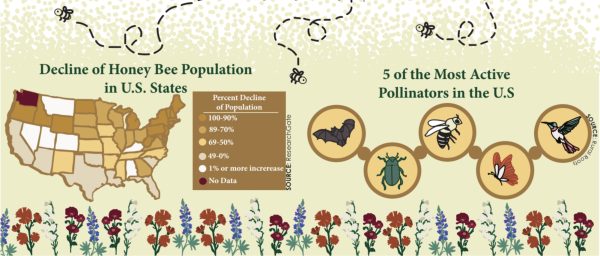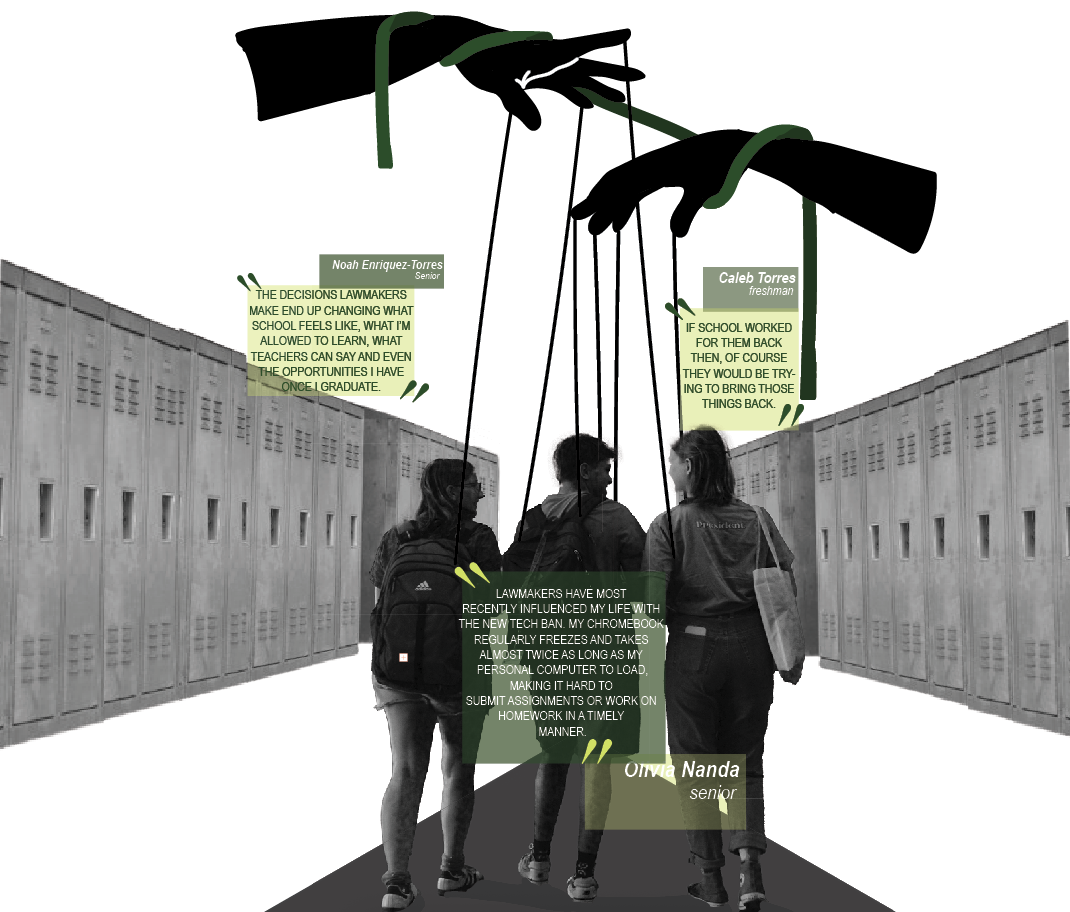Buzzing to the tempo of his wings, a bee, in the crowd of many, graces the Texas Wildflower Center with fuzzy streaks of black and yellow as he pollinates one thriving blossom after another. His tiny wings moving against the garden’s winds, are doing their not-so-tiny part to keep the ecosystem alive.
The small but mighty insects play a major role in the survival of crops and wildlife all throughout Texas and the United States, but their populations are declining at a rate many experts find unsettling. In recent years, many have joined the fight for their protection in fear of losing the mighty
THE BEES
The fuzzy buzzers, which inhabit zones on almost every continent, are well known for being one of the world’s largest pollen contributors. According to a study published in The Conversation, there are approximately 3.5 trillion honey bees worldwide, or about 440 per person.
“It’s kind of hard when you’re looking at a singular bee and you think, wow, that is so small I could just kill it, but they really are a massive part of our ecosystem,” Bowie bee club president Pluto Trippe said.
The job of a honey bee is one that many animals and insects have, but there are several reasons that bees are the front runners. Nona Evans, the Founder of the non-profit organization Whole Kids Foundation and owner of over 90 hives of feral bees along with her husband, cited that pollinators account for a third of the food on our plates, with honey bees making up 70-80% of that third.
“There are really several facets to the honey bee connection with our environment, and it all stems around pollination,” Evans said. “So, the connection that most readers will know and should care about is that honey bees are responsible for an incredible amount of the food that we eat.”
All pollinators, including honey bees, play an important role in more than just food production. The ecosystems are made of a web of organisms that live off of each other, plants and animals alike, and the collapse of an ecosystem often comes from a disruption in the balance in the relationship between these organisms.
“Bees are not the only pollinators, but they are one of the biggest,” bee club vice president Palmer Schmitt said. “People don’t understand how big of a deal it really is, because pollinating does help plants grow, but it also helps them spread their seeds properly. It helps them grow up, not only faster, but a lot stronger.”
Although the world is home to a plethora of different ecosystems, bees are present in almost each and every one. Their environmental contributions span across large ranges of climates and vegetation types.
“The evolution of their genetics tends to make them more resilient to our climate,” Evans said. “They’re adapted to our super hot summers, our droughts, all the crazy weather that we have here. And the same can be said for bees in other parts of the country, they adapt to their environment and their genetics evolve to help them survive in the places that they live.”
In Texas, the honey bees deal with a variety of vegetation diversity, including the Texas famous wildflowers, which attract pollinators like honey bees. In an article from Arkansas Agricultural Experiment Station (AAES) in 2023, associate professor of entomology for the AAES Neel Joshi, described how colors help bees identify sources of pollen and nectar.
“Bees definitely play a big role here in Texas, the ones at Bowie, they love to take from the Wildflower Center, which is nearby and home to the majority of flowers in the area,” Schmitt said. “Plants grow much more consistently when they’re pollinated, they don’t have as many struggles to worry about. A lot of plants in Texas rely on pollination to help them grow.”
POPULATION DECLINE
In recent years, the world’s honey bees are facing several environmental factors that are threatening their population. According to an article from Penn State, several studies have shown that beekeepers have lost approximately 30 percent of their population each year since 2006.
“It’s becoming hard for them to live, with humans being their number one threat,” Trippe said. “Then we are also being a threat to the environment, that becomes a threat to them as well.”
Honey bees are up against a number of challenges for survival, with pressure from many of these increasing in the past few decades. Climate change is one of these factors. According to an article from the U.S. Department of Agriculture, the warming of the planet and changes in weather patterns are altering the synchrony between flowering plants and their pollinators.
“There’s a term called colony collapse. And the confusing thing is, it’s not one thing, it’s the summation of many things,” Evans said. “Honey bees specifically prefer to live in the hollowed out trunks of trees. What we know about a hollow tree is that it’s either dying or dead and with all of the weather and the climate change that we’ve had of late, the crazy freezes and the storms that we’re having are blowing down more and more dead trees.”

Some of the threats that bees face are threats common to nature, those that would affect colony survival regardless of human intervention, including other animals like voreala mites who, according to a 2022 report from the U.S. Department of Agriculture, are responsible for almost half of bee population stressors.
“They are parasites that both bite and feast on the bee, but more importantly, they get into the cells of the honeycomb where the larva are developing, and draw the fat out of those developing larva so that the bees that are then born are deformed and can’t thrive,” Evans said.
Though threats like parasites, and other predators are a part of the natural ecosystem, the decline in honey bee population is largely in part to the human interaction with their habitat. Human use of agricultural land, and the way that they use it, can pose a number of threats to a honey bee’s source of food and shelter.
“Another thing I always like to educate on are pesticides and herbicides,” Evans said. “There’s an herbicide called a neonicotinoid, and it is especially damaging to our honey bee colonies. “
Bees face a number of environmental and human threats to their populations, and without action, the pattern in their population decline might result in consequences to world ecosystems more dire than many are grasping.
“They’re fighting, but the numbers are going down,” Schmitt said. “Everything goes back to living off plants at some point in the food chain. And bees are incredibly important for plant life. So, if bees go away, the plants die down. And then the bugs that eat the plants die, and the birds that eat the bugs die, and then it’s a big issue. It’s like taking a piece out of a Jenga tower.”
PROTECTIVE EFFORTS
However, hope for the bees to overcome the decline reported in the past years is not lost. There are several efforts world-wide to combat the many threats faced by honey bees, from legislative regulations to organizations, to clubs like the one here at Bowie.
“There’s still a lot of work to be done, but I like to see all of the legislation that’s coming, that’s reducing or creating safer pesticides,” junior bee club member Emily
LeJeune said. ”I also like to see that some regular farmers who aren’t beekeepers at all, are keeping bees on their farms.”
In Austin particularly, there are several large groups and organizations that are dedicated to the protection of bees. There are beekeeping associations for almost every county in Texas, where beekeepers can come together to share experiences.
“There are lots of efforts happening at the state level, like the University of Texas has a Bee-vo society that is working to educate students about the wonders of honey bees,” Evans said. “There are lots of educational efforts, and there are non-profit organizations that are doing what they can.”
There are several things every individual can do to protect the pollinator population, including planting flowers and gardens, opting for organic food products that specify no use of herbicides and pesticides, simply refraining from destroying bee hives near your house, and more.
“I always tell people, if you have a plant outside that sits in one of those saucers, pick one saucer and just let it get all mucky with algae,” Evans said. “That algae that forms is really nutritious for our bees. And once you’ve learned a little bit, share it with others, because not enough people truly understand how important and how fascinating honey bees are.”
Efforts like Evan’s and her husband’s program, Texas Sassy Bees, which sponsors schools to keep bee hives, provide education on the importance of pollinators to kids of several ages.
“You don’t have to know everything,” Trippe said. “There’s so much that people don’t know and it’s kind of sad. I’m really hoping that as we kind of grow as a society, and we have the realization that, hey, climate change is affecting us, we can also have the realization that we need the bees.”
Between organizations, educational programs, and clubs like the one here at Bowie, there are several efforts towards protecting the population of pollinators that are so influential in our environment’s success.
“People are starting to pay more attention to how crucial bees are for our everyday life,” LeJeune said. “There’s a saying that goes ‘if bees went extinct, human populations would go extinct, and people really doubt that, but it’s true.”







